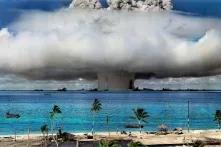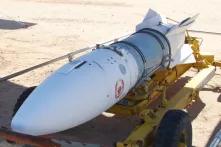Remy Zahiga, a young Congolese climate and social justice activist, explores the history of the uranium used for the production of nuclear weapons that were dropped on Hiroshima and Nagasaki during the Second World War. He also analyses the ramifications for people living nearby Shinkolobwe mine in the Democratic Republic of Congo (DRC).

Located in the heart of Africa, the Democratic Republic of Congo (DRC) is known for being one of the largest countries on the African continent, with natural wealth and forest cover, which are characteristic of its location on the world map. The southeastern part of this vast country cuts through a mineral belt known as the “Copperbelt”. In this region, the colonial history of the Shinkolobwe mines (in Katanga), rich in uranium and managed by the Belgian company Union Minière du Haut-Katanga (Mining Union of Haut-Katanga) between 1921 and 1959, was directly linked to the production of the atomic bombs dropped on the Japanese cities of Hiroshima and Nagasaki in August 1945 during World War II.
From the year 2000, the Shinkolobwe mine was taken over by small-scale miners extracting copper and cobalt with no protection against radioactivity. Marketing and exportation of crude ores from the mine during this period led to the transfer of copper- and cobalt-containing products outside of the Congolese borders. In the interests of ensuring national security and the safety of the population, the Congolese government prohibited mining activities in the Shinkolobwe mine in 2004 by means of a presidential decree.
Nowadays, the African continent is considered a nuclear-weapon-free zone by virtue of the Treaty of Pelindaba. The DRC also joined 92 other countries in signing the Treaty on the Prohibition of Nuclear Weapons in 2022, which forbids the use and production of nuclear weapons, which in turn rely on uranium ore from around the world.
Advocacy to ban the use of nuclear weapons
The treaty, which prohibits the use and production of nuclear weapons, adds that assistance must be provided to the victims of the whole nuclear fuel cycle and thus also to the communities affected by these now-forbidden mines.
For this reason, during the Nuclear Ban Week Vienna conference, I repeatedly called for urgent measures to provide justice and redress for the local populations living around the mine, who are still suffering its consequences today. As a Congolese activist for peace and social justice, I am finalising a study into the humanitarian situation and environmental impact of the Shinkolobwe mine, which shows copper, cobalt, zinc and lead pollution, as well as slight uranium pollution, at certain points sampled in the River Panda. This river runs through the Shinkolobwe mine and other active industrial mines in the Haut-Katanga region. I am a trained geologist, and my work with local people has enabled me to defend their rights and make their voices heard, to ensure that nothing is done without first consulting them. But it is not easy in the DRC.
Despite the measures adopted by the Congolese state, illegal mining continues. The price of these precious metals is constantly increasing, and worldwide demand for raw materials is shooting up due to current technological progress and the energy transition. Moreover, according to the UN Secretary-General, “a new arms race is picking up speed” and “[a]lmost 13,000 nuclear weapons [are] held in arsenals around the world”. At a time when many nations are engaged in an arms race, stockpiling weapons of mass destruction to prove their “strength”, Shinkolobwe mine still risks being seen as an attractive prospect.
What about the victims at the local level?
After mining was prohibited at the Shinkolobwe site and illegal mining without necessary protection and safety measures had led to various accidents and deaths, in 2004 around 15,000 inhabitants were evacuated from their village near the mine, according to the 2004 OCHA/UNEP report. Sifa, a mother of four, was one of them, and now lives in Likasi (DRC). She still remembers the event as it happened almost twenty years ago, which she describes as “brutal”.
Her husband, Charles, was a small-scale miner in the mine, and the family relied on his job to survive. The day they were evicted was an ordeal for Sifa: “I spent the night outside with my children, as our house and our neighbours’ houses had been burnt down. My heart ached seeing my children cry and knowing that I had nothing to give them to eat. I couldn’t afford transport from Shinkolobwe to here, to Likasi, and I was worried about my husband, as the soldiers in charge of security at the mine were on the hunt for small-scale miners. My husband died in 2010 after a serious illness. I have to look after my children alone now”, she says.
Ilunga, a former small-scale miner at the same mine, now lives in the village of Mwobesa, a few kilometres southeast of Shinkolobwe. He says that his health has got worse and worse after his long period of work in the mine. In the absence of a scientific explanation, Ilunga suspects that he was exposed to heavy metals and radioactivity in the mine: “I can’t breathe properly and every time I go to the hospital, the doctors say they can’t find any sort of illness. I don’t have the strength to work, nor the financial means to seek treatment in a large hospital or abroad.” He also recalls that in 2006, the wife of one his mining colleagues gave birth to a child with deformities who died one week later.
It is very likely that the baby’s birth defect was linked to exposure to radioactivity from the mine, as shown by this study from the United Nations Institute for Disarmament Research (UNIDIR), which reveals that women are more vulnerable to radiation than men.
Sifa’s story, as a widow and mother, echoes that of many other families who lived in the village of Shinkolobwe, most of whom no longer have any means of subsistence and have been abandoned by the Congolese state, which never provided compensation. Many former miners like Ilunga are still living with the consequences of their time in the mines before their eviction in 2004.
Towards an energy transition to prevent climate crisis – but at what cost for local communities in the DRC?
Although the Congolese government has signed and ratified the Treaty on the Prohibition of Nuclear Weapons, the subsoil of the DRC is still being eyed in order to power the world into a clean energy future. The consequences of this are many and varied human rights violations, conflicts and increased poverty.
In 2021, a study by the International Monetary Fund (IMF) showed that “[t]he clean energy transition needed to avoid the worst effects of climate change could unleash unprecedented metals demand in coming decades, requiring as much as 3 billion tons.” However, the prices of precious minerals are increasing, as well as demand for raw materials. Despite the presence of large foreign multinationals such as Glencore (Katanga), Kibali Gold Mine (in the northeast), Alphamin (Nord-Kivu) and CMOC Group (Katanga), as well as many other mining companies in partnership with Gécamines, Sokimo and Sakima, the Congolese population lives in extreme poverty, even though the country’s subsoil is known for its riches. The World Economic Forum states that “a fifth of people in Africa are suffering from chronic hunger”, and although the African continent contributes least to emitting greenhouse gases into the atmosphere, it is one of the regions most affected by and most vulnerable to the climate crisis.
With more than 80 percent of the world’s cobalt reserves located in the Congo, more and more mining operations are setting up in the province of Haut-Katanga and other parts of the country. Day and night, excavating machines chip away at the industrial mines. Thanks to its forest resources (Congo basin), water resources (Congo river) and “transition ores”, the DRC is presented as a solution country to climate change. Proper management of its assets should provide an opportunity for development, at a time when its population is still living in poverty. However, local populations are being deprived of their means of subsistence.
Elisabeth, aged 54, was shocked to lose a field belonging to the family near the village of Sandra, to the west of the mining town of Likasi, Haut-Katanga, which she had always used for farming. “I no longer have anywhere to plant my vegetables to feed my family, I’m not allowed to go there because there’s a mining operation there now, and I have received no compensation,” she says.
Haut-Katanga is one of the provinces affected by mining of “strategic ores”. The central government provides research and operation permits to multinationals in the areas where local people live and work, posing a threat to their survival. The permits are awarded with a complete lack of transparency and total disregard for the local populations. The consequence of this is that local people are evicted from small-scale mining sites, leading to fighting and deaths, loss of their land (fields and houses) and the expansion of mines into inhabited areas. This can be seen in the village of Luisha, north of the town of Lubumbashi, where the Lubusha school is under threat of being displaced by mining companies.
To make use of small areas which are not occupied by multinationals, local communities carry out small-scale mining in terrible, archaic conditions, risking their lives to put food on the table. In Mukumbi, Kikala, aged 43, works with his son Blaise, aged 15, in a small-scale cobalt mine. “I have to fight to feed my family,” he says. “Blaise and I work to pay the school fees of his eight younger siblings.” An Amnesty International study published in 2023 refers to a UNICEF estimate from 2014 which reveals that almost 40,000 children work in the mines of the DRC, sacrificing their future to provide for their families’ needs.
The mines have long been seen as a driver of development, and they should be helping to build schools, hospitals and roads, and contributing to the state’s budget. But instead, they are filling the coffers of foreign companies and jeopardising the future of local populations, who are suffering the effects of radiation and pollution of their soils and rivers.
It is therefore vital that these populations receive compensation, and that security around the Shinkolobwe mine be improved in collaboration with civil society. The Congolese government must also set up a strict monitoring committee to ensure close collaboration between local people and multinationals, to ensure inclusion of the people most affected by mining activities, especially prior to awarding contracts to multinationals.
Note: This article was originally written in French. This is a translated version.


